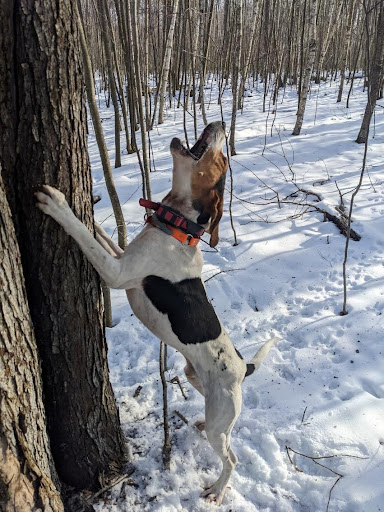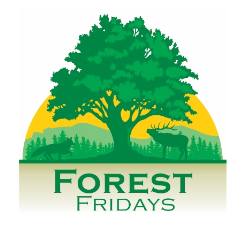Forest Fridays: Squirrel dogging
By Eric Probert, Forest Fridays
Growing up at the base of a mountain in Northwestern Clinton County, one of my passions as a youth was loading my single shot 20 gauge and pursuing squirrels. Still hunting across a grape vine choked red oak sidehill or sitting quietly in a hickory flat waiting for squirrels to appear was probably how most young hunters cut their teeth on the sport in Penns Woods. As I grew older, the thought of hunting those bushy tails faded as I grew more interested in chasing deer and bear through the same hills.
Luckily for me, I had the pleasure of working with a man named Evan Wharton at the Sproul State Forest. Evan had moved back to his native Pennsylvania after a career in the river barge shipping industry that had him stationed in Louisiana. In the south, Evan got an education on squirrel dogs and he brought what he learned back north. Evan was always asking me to go hunting with him and a little mutt that he claimed could tree squirrels as fast as we could shoot them. Who has time to hunt squirrels when they can chase more important critters in the fall? After a few years of invitations from him I agreed to accompany him on a hunt. My son was 10 years old at that time and it seemed like the perfect opportunity to start getting him interested in the small game hunting that most young hunters are so excited over.
Evan introduced me to a world of hunting that I knew nothing about. That trip to the woods with the little dog of Evan’s was probably the most fun I ever had in the woods. We got three limits of squirrels that day and that little red Mullins Feist dog was everything he bragged him up to be.
Hunting squirrels behind a dog can be described as raccoon hunting with a dog, except with the lights on. Once the dog is cut loose the hunter waits for the dog to locate and tree a squirrel. The dog uses his nose, eyes, and ears to locate a squirrel. Once the squirrel is located the dog will stay at the tree with the squirrel and “bark treed” until the hunters arrive. Some of the more experienced dogs will learn to develop their sense of smell to that point that they will be able to “wind” a squirrel from several hundred yards away in the tree. Once the hunters arrive at the tree, it is now up to the hunters to spot the squirrel and make the shot. Circling the tree while scanning the branches for a tuft of hair of a glimpse of a tail takes some practice and a good pair of binoculars. A laser pointer to point out the hiding bushy tail for younger hunters is also good addition to a hunter’s vest. Sometimes the squirrel will hide in a den tree or a nest. The dog handler will have his dog trained to be led off the tree and will tell him, “In a hole, can’t get him,” then the dog will start hunting for the next squirrel.

After our first experience hunting with a squirrel dog, my son and I promptly decided to search for a squirrel dog pup. With the blessing of mom, we started our search. There is a whole culture of hunting squirrels with dogs in the United States and most of it exists in the southern half of our country. After some research I soon learned about the different “breeds” of dogs used to pursue bushy tails.
Squirrel dogs come in many shapes and sizes. But most of the so-called breeds are not your typical dogs that you would see in the Westminster dog show. These bloodlines are mixed from centuries of hunters who bred their dogs for intelligence, grit, and hunting ability. Several of the most popular dogs used in pursuit of squirrels include Feist, Mountain Cur, Treeing Cur, and Hounds. Many of these types of dogs are cross bred to get the traits of each type. For example, a Walker Hound could be bred with a Mountain Cur. The notorious nose and treeing ability of the hound would be teamed up with the relatively higher intelligence of the Mountain Cur. The resulting cross would be labeled by these hunters as a Treeing Cur. Several breeders across the United States are well know in their ability to produce proven squirrel dogs with a high percentage of success. These folks are well known in the squirrel dog world. Names such as Jody Mullins, Steve McAndrews, Bill Barger, and Dean Wright will be immediately recognized by someone that’s active in the sport of chasing squirrels with dogs.
Training a dog is relatively simple if you start with the right pup. Doing some research and finding the right breeder is half the battle. When I started, I asked a lot of questions to some of the men that I got to know through my research. Several of them told me the same thing, “Buy yourself a new pair of boots and lace them up tight, when they are worn out you will have a squirrel dog.” or “keep your dog in the woods.” Those statements turned out to be the best advice that can be given on this endeavor. It really can be that simple.
The enjoyment of walking through the woods on a crisp November morning and hearing a dog call “treed” in the distance is one of the rites of fall for me now. Seeing a young dog starting to figure things out is best described as the same feeling you get by seeing your son or daughter get their first base hit on the ball field. Hunting with a squirrel dog is also the best way I have found to introduce young hunters to the outdoors. Its fun, not stressful, and provides lots of action. You don’t have to sit quietly in a deer stand, and you learn to be a steady shot with a rimfire rifle. Not to mention all the teachable moments along the way such as dendrology and mast crop identification. All of which builds a base for young hunters and possibly a future career in forestry.
If you get an opportunity to hunt over a squirrel dog, don’t pass it up!
About the author: Eric Probert
Eric Probert has been employed by DCNR Forestry as a Forester since 1998, currently as a Silviculture Program Specialist. Eric graduated from Penn State University with a Bachelor of Science degree in Forest Science. He lives with his wife, family, and hunting dogs in Clinton County. He enjoys hunting, fishing, bird watching, and generally any outdoor-related activity.



